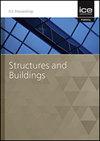纯弯曲矩形管状混凝土翼缘梁的数值模拟
IF 1.4
4区 工程技术
Q3 CONSTRUCTION & BUILDING TECHNOLOGY
Proceedings of the Institution of Civil Engineers-Structures and Buildings
Pub Date : 2023-10-25
DOI:10.1680/jstbu.21.00116
引用次数: 0
摘要
本文对矩形管状混凝土翼缘梁(cfrfg)的受力性能进行了详细研究。这是一种钢梁,其顶部法兰板被混凝土填充的钢截面所取代,与相同比例的普通钢梁相比,具有更大的承载能力和抗侧扭屈曲能力。这些是复杂的成员,它们的行为是由几个相互关联的参数所控制的,本文将对这些参数进行研究和讨论。利用Abaqus程序,建立了简支cfrgs的三维有限元模型,研究了其受弯性能。利用已有的实验结果;计算模型被验证,然后被用来研究最显著的性质对整体响应的影响。一个简化的分析模型是基于一个基本的评估行为,预测这些类型的截面的能力,以一种适合设计师的方式。将计算结果与有限元分析结果进行了比较,结果表明,分析模型能够准确地描述弯矩的行为和能力。本文章由计算机程序翻译,如有差异,请以英文原文为准。
Numerical modelling of concrete-filled rectangular tubular flange girders subjected to pure bending
A detailed study of the behaviour of concrete filled rectangular tubular flange girders (CFRFGs) is described in this paper. These are steel beams in which the top flange plate is replaced with a concrete-filled steel section, resulting in greater load-carrying capacity and lateral torsional buckling resistance compared with a regular steel beam of similar proportions. These are complex members and their behaviour is governed by several inter-related parameters which are studied and discussed herein. Using the Abaqus program, a three-dimensional finite element model is developed to investigate the flexural behaviour of simply supported CFRFGs. Using available experimental results; the computational model is validated and is then employed to study the influence of the most salient properties on the overall response. A simplified analytical model is presented based on a fundamental assessment of the behaviour, to predict the capacity of these types of section in a way that is suitable for designers. The results are compared to those from the finite element analysis and it is shown that the analytical model is capable of providing an accurate depiction of the behaviour and the capacity of bending moment.
求助全文
通过发布文献求助,成功后即可免费获取论文全文。
去求助
来源期刊
CiteScore
3.40
自引率
6.20%
发文量
61
审稿时长
12 months
期刊介绍:
Structures and Buildings publishes peer-reviewed papers on the design and construction of civil engineering structures and the applied research associated with such activities. Topics include the design, strength, durability and behaviour of structural components and systems.
Topics covered: energy conservation, people movement within and around buildings, strength and durability of steel and concrete structural components, and the behaviour of building and bridge components and systems

 求助内容:
求助内容: 应助结果提醒方式:
应助结果提醒方式:


